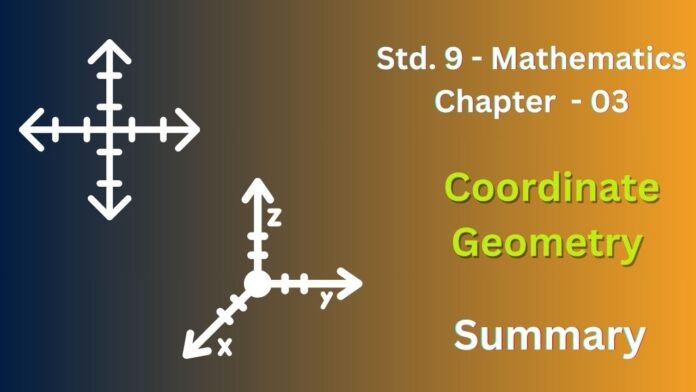Coordinate geometry is a branch of mathematics that combines algebra and geometry. It provides a method to represent geometric shapes and figures algebraically and vice versa.
Key Concepts
- Cartesian Plane: This is formed by two perpendicular number lines, the x-axis (horizontal) and the y-axis (vertical), intersecting at the origin (0, 0).
- Ordered Pair: A pair of numbers (x, y) representing the coordinates of a point in the plane. The first number (x) is the x-coordinate, and the second number (y) is the y-coordinate.
- Quadrants: The plane is divided into four quadrants by the x-axis and y-axis. The signs of the coordinates determine the quadrant in which a point lies.
- Plotting Points: Given the coordinates, points can be located and plotted on the Cartesian plane.
- Distance Formula: Used to find the distance between two points in the plane.
- Section Formula: Used to find the coordinates of a point dividing a line segment joining two given points in a specified ratio.
Importance
Coordinate geometry is a fundamental tool in various fields, including physics, engineering, and computer graphics. It provides a visual representation of algebraic equations and helps solve geometric problems using algebraic methods.
Exercise 3.1
1. How will you describe the position of a table lamp on your study table to another person?
Ans :
To locate a table lamp on a table, imagine the table as a flat surface with two perpendicular edges. These edges can be considered as the x and y axes. The position of the lamp can then be determined by measuring its horizontal and vertical distances from the chosen origin (a corner of the table). These distances correspond to the x and y coordinates, respectively, specifying the lamp’s exact position on the table.
2. (Street Plan): A city has two main roads which cross each other at the centre of the city. These two roads are along the North-South direction and East-West direction. All other streets of the city run parallel to these roads and are 200 m apart. There are 5 streets in each direction. Using 1 cm = 200 m, draw a model of the city on your notebook. Represent the roads/streets by single lines.
There are many cross-streets in your model. A particular cross-street is made by two streets, one running in the North-South direction and another in the East-West direction. Each cross street is referred to in the following manner: If the 2nd street running in the North-South direction and 5th in the East-West direction meet at some crossing, then we will call this cross-street (2,5). Using this convention, find:
(i) how many cross-streets can be referred to as (4,3).
(ii) how many cross-streets can be referred to as (3,4).
Ans :
Exercise 3.2
1. Write the answer of each of the following questions:
(i) What is the name of horizontal and the vertical lines drawn to determine the position of any point in the Cartesian plane?
(ii) What is the name of each part of the plane formed by these two lines?
(iii) Write the name of the point where these two lines intersect.
Ans :
(i) The horizontal line is called the x-axis and the vertical line is called the y-axis.
(ii) Each section of the plane created by these two lines is known as a quadrant .
(iii) The intersection point of these two lines is called the origin.
2. See the given figure and write the following:
(i) The coordinates of B.
(ii) The coordinates of C.
(iii) The point identified by the coordinates (-3,-5).
(iv) The point identified by the coordinates (2,-4).
(v) The abscissa of the point D.
(vi) The ordinate of the point H.
(vii) The coordinates of the point L.
(viii) The coordinates of the point M.
Ans :
(i) The coordinates of B: (2, 2)
(ii) The coordinates of C: (5, -5)
(iii) The point identified by the coordinates (-3, -5): E
(iv) The point identified by the coordinates (2, -4): H
(v) The abscissa of the point D: 5 (Abscissa is the x-coordinate)
(vi) The ordinate of the point H: -4 (Ordinate is the y-coordinate)
(vii) The coordinates of the point L: (1, 5)
(viii) The coordinates of the point M: (-3, 4)


